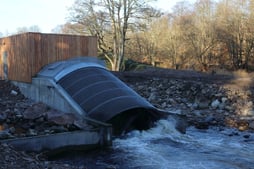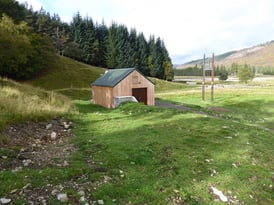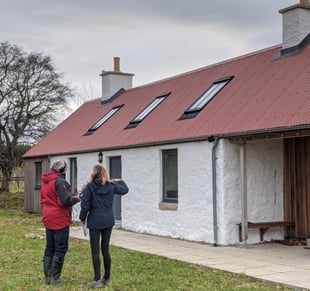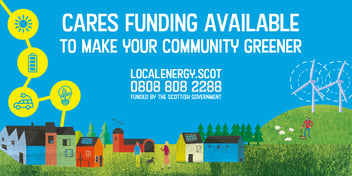Community Energy Schemes
NESCAN Hub
#Buildings & Energy
Publish Date: March 2024
Last Updated: March 2024
The Local Energy Policy statement published on January 2021 set out the approach of the Scottish Government to help and inform decisions of all those participating in or developing local energy projects as Scotland's energy system transitions to a low carbon future.
The Scottish Government’s ambition is to have 2GW of community and locally owned energy by the end of 2030.
Generating energy from community-owned assets is an opportunity for community wealth-building. Either the energy can be sold to the grid, generating income that can fund local community projects, or it could be used to heat and power local homes and businesses.
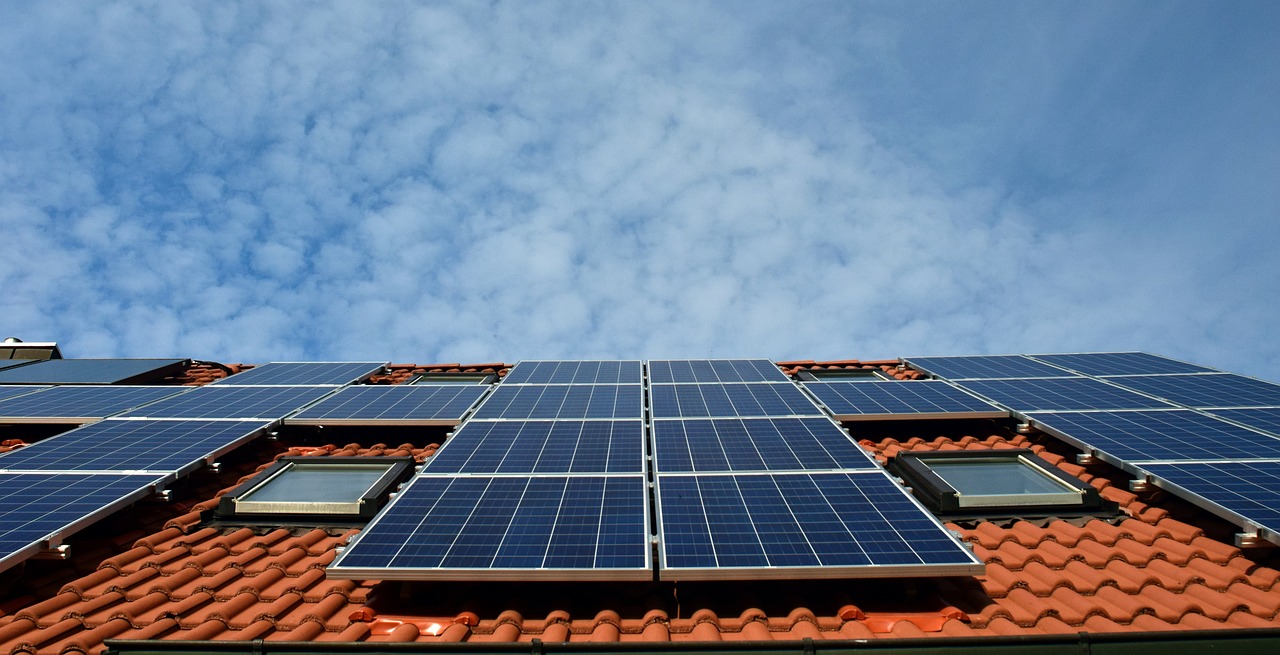
We can generate renewable energy in all sorts of ways, either as individual households or as several households coming together to create a community energy scheme. Here are the types of renewable energy schemes that people/ organisations/ community groups can set up:
- Wind turbines are possibly the most familiar type of renewable energy scheme, and in some cases controversial;
- Once installed, Hydroelectric schemes can last for 40-50 years, with low running and maintenance costs, and could last for longer if well maintained. See Guide on planning permission and licences.
- Solar Panels
- Energy can be generated from waste using several different strategies. These include combustion, gasification, pyrolysis, anaerobic digestion and landfill gas recovery. Heat is generally created as a waste product of these plants and can be used to hear nearby homes and buildings.
- Geothermal energy is the heat produced deep in the Earth's core and a clean, renewable resource that can be harnessed for use as heat and electricity.
- Biomass is a renewable energy source generated from burning wood, plants and other organic matter such as manure or household waste. It releases carbon dioxide when burned, but considerably less than fossil fuels.
The Green Homes Network comprises homes of all kinds; from eco-builds to historic stone cottages, listed buildings and features more than 300 homes across Scotland with renewable technologies such as heat pumps and solar panels. You can arrange visits to see and understand the different technologies.
Community Energy Projects
There are some inspiring Scottish examples of local energy projects and great local community led energy projects:
Local Community Wind turbines
Set up in 2009, Huntly Development Trust is involved in three wind energy projects that generate a steady income, as well as other initiatives to progress the energy transition in Huntly and District. They have installed their own wind turbine at Greenmyres, and have agreements with two other local wind turbine operators to administer a fund from a percentage of the profits to benefit the community.
Udny Community Trust in Aberdeenshire have their own community-owned turbine at Tillymaud Farm, operated by Udny Community Wind Turbine Company Ltd. Initial annual income of around £50,000 is expected to rise to over £150,000 after the bank loan has been repaid. The funds are managed by the Udny Community Trust to improve the quality of life for all Udny residents by supporting a wide range of development activities including Planning for Real. Their project was featured in Community Energy News Spring 2010.
The Fetterangus Community Association aim is “to maintain a thriving and happy Fetterangus community who can afford to invest and develop village assets and services for their own well being and enjoyment”.
The Association manages income from electricity generated by the 77-metre tall turbine, which brings in around £75,000 a year for the Buchan village of Fetterangus, known locally as Fishie and home to around 480 people. The income from feed-in tariffs earned by supplying energy to the national grid is spent on regenerating the local community and encouraging youngsters to stay in the area. You can find out more about the Fetterangus community journey from the Fetterangus Community Action Plan November2015
Pioneered by the Fetterangus Community Association and inspired by similar schemes on the islands of Gigha, Tiree and Lewis, the £1.5 million project took nine years to come to fruition. Managed by Fetterangus Power Ltd, the project was funded by the Scottish Government’s Community and Renewable Energy Scheme (CARES), the Big Lottery and a loan from Triodos Bank.
Triodos has been involved with the Aberdeenshire project since 2007. It has another similar development at Gòb Sgùrabhal, the most north-westerly point of the Isle of Barra. “As the loan gets paid off, the income stream will increase. With that sort of money behind it, a community gains confidence and can borrow to fund other, bigger schemes in the future.”
Local Hydro schemes
The Donside Hydro harnesses energy from the River Don to generate electricity that is sold to the national grid. Income from the project is channelled into initiatives that will achieve social and environmental benefits for the local regeneration area.
Commissioned in 2016, the Donside Hydro is Aberdeen’s first community energy project; Scotland’s first urban community hydro; and the UK’s widest Archimedean screw turbine (CARES funded; capacity 0.1MW).
Managed by the Community Benefit Society Aberdeen Community Energy (ACE), the Donside Hydro is owned and run by the community. Their vision is to deliver on the ethos of a sustainable community that works for local residents, visitors and the area’s natural riverside setting. Their aim is to deliver a project that is aligned with local and national government policy on energy, climate change and sustainable communities.
The Braemar Community Corriemulzie Hydro generates income by producing 100kW electricity, and is operated by Braemar Community Hydro Ltd.
The Community Benefit Society Braemar Community Limited took forward the initial feasibility study for the Corriemulzie Hydro. The ambition of Braemar Community Ltd is to “support the village of Braemar via the management of community assets and delivery of projects for the benefit of residents and the visiting public.” Their website shows the success of their endeavours with 256 company members from a community of around 500; £4M of projects underway; and in 2020, over £1M was raised in support of community projects. This illustrates the potential for engaging a broad section of the community with community wealth building.
Solar
A recent Aberdeenshire Council Community Energy Household Survey explored options for generating electricity to sell to local households. They are considering building a solar farm and some wind turbines on land owned by the council. Instead of selling the electricity to big organisations, there is now a way for the Council to sell electricity locally, helping households reduce their costs. The same approach could be taken when the Council puts solar panels on its own larger buildings and generates more electricity than the building needs.
Edinburgh Community Solar Cooperative owns and operates 30 solar panel installations throughout Edinburgh with a total generating capacity of 1.38MW. Panels have been installed on Edinburgh Council schools, community centres and leisure facilities. Each year they generate approximately 1.1GWh of clean, renewable electricity for these buildings and the wider grid. After providing a fixed return on member’s investments, excess profits are invested in community projects throughout Edinburgh that promote sustainability and renewable energy.
Banks o'Dee Sports Club worked with Zero Waste Scotland to install new LED floodlights that can be independently controlled (thereby reducing the costs of running their floodlights by 65%). The costs have now been further reduced by the installation of solar panels and batteries.
Energy generated from waste
Garioch District Heat is a local community-led district heat scheme that is intending to use the energy from the new waste incinerator to be built at Thainstone Industrial Park. Garioch District Heat has been assisted by Energy4All, which works with communities to develop community-owned innovative renewable energy projects, helps raise the funds needed for the projects to go forward, and provides advice during the construction process. You can read more in this article from Scottish Construction Now.
Support for Community Energy Schemes
The Local Energy Scotland consortium comprises the Energy Saving Trust, Changeworks, the Energy Agency, and SCARF. Together, they manage and administer the Scottish Government's Community and Renewable Energy Scheme.
CARES encourages the local or community ownership of renewable energy across Scotland. The programme aims to accelerate progress towards the Scottish Government’s target of 2GW of community and locally owned energy by 2030. The goal of CARES is that communities across Scotland are engaging, participating and benefiting in the energy transition to net zero. This is achieved through funding and support for community groups to install renewable energy generation.
Community Energy Scotland provides independent and ongoing practical & technical support for community project development. They support member organisations to link up and network with each other and with policy makers. They provide a collective voice and represent members at policy level.
Energy4All was formed in 2002 to expand the number of renewable energy co-ops in the UK. They offer advice and assistance and a package of sector, admin, and financial services to Co-ops in return for an annual fee.
Funding Available
The Community Heat Development Programme is funded by the Scottish Government through the CARES scheme and delivered by Local Energy Scotland. It’s a learning programme, supporting communities and groups of householders who want to work together to make buildings in their communities more environmentally friendly to heat. The programme won’t pay to install energy efficiency measures or renewable technologies such as heat pumps. Instead, expert advisors work with successful applicants to test their ideas and develop feasible options to change the way buildings are heated. Successful applicants will also receive advice on next steps, including any potential routes for further funding.
Lets Do Net Zero Community Building Fund helps community organisations reduce their building energy costs and greenhouse gas emissions by installing renewable technologies such as heat pumps, batteries, and solar photovoltaic panels, along with energy efficiency measures. Grants of up to 80% of eligible costs up to a maximum of £80,000 are available until 31 March 2025. Funding is subject to availability and subject to the applicant’s ability to complete the project and claim all funds by 31 March 2025.
The Let’s Do Net Zero: Off Electricity Grid Communities Fund aims to decarbonise and future-proof the existing local independent electrical grids of those communities that are not connected to the national electricity grid. The support available from the Scottish Government’s Community and Renewable Energy Scheme (CARES) will help these communities to work towards becoming net zero communities. With more resilient infrastructure these local grids will be able to provide reliable power and be on a path to supporting the decarbonisation of heat.
The Community Learning Exchange funded by the Scottish Government, is one of the ways the Scottish Community Alliance seeks to support local community activity and invest in the work of our membership across Scotland. The fund offers small pots of money to build levels of mutual support across the Community Sector through peer-to-peer learning. Particularly for these high cost, long term projects, the best way to test and develop new ideas is to learn from people already on the journey themselves!
Further reading –
Read a first-hand account from 2014 of the experience of setting up a community hydro scheme in Lancaster Halton Lune Hydro.
How Community energy can help the UK reach net zero
CASE STUDY – Huntly Development Trust
In 2014, Huntly Development Trust was able to acquire Greenmyres, a 63 acre rural site four miles South East of Huntly, and create a biodiverse woodland and wetland.
In 2016, construction work started on the Greenmyres Community Wind Project with the support of a £500,000 grant from the Scottish Land Fund and a £2 million loan from the Clydesdale bank. The 500kW Enercon E48 turbine is located at Greenmyres Farm. The site was chosen to make the turbine appear as a visual extension to nearby operational Dummuies wind farm. The turbine has the capacity to produce enough energy for the equivalent of 300 Aberdeenshire homes every year whilst generating income in the region of £2.5 million over its 20-year lifetime for community-based projects. Read more here.
In late 2010, wind developers West Coast Energy approached HDT with their proposal to create a wind farm at Cairnborrow, Glass near Huntly. Together they created a ground-breaking community partnership agreement designed to ensure that the local community would benefit from the development, and by 2015, planning permission was received for five wind turbines, which were commissioned in 2016.
The agreement between Cairnborrow Wind Energy Ltd and HDT states that HDT will receive an annual community benefit payment based on the higher of £5,000/MW installed or a 10% share of the scheme’s annual profits. Over the lifetime of the project, the fund is expected to be worth a total of around £3,000,000 to the area.
HDT manage and invest 75% of the funds for the benefit of the wider AB54 area. The other 25% is reserved for the parishes of Cairnie and Glass, i.e. those nearest the wind farm. Representatives of the Cairnie and Glass communities have joined together to create the Cairnie Glass Community Trust to manage the 25% fund and support a variety of local initiatives.
In 2016, the Community Interest Company Cnoc Cailliche Ltd erected a second wind turbine at Wheedlemont, just outside Rhynie. HDT entered an agreement with the developer to receive and manage a voluntary community benefit fund arising from the turbine. Over the lifetime of the project the fund is expected to be worth a total of £650,000 to the area. 75% of the funds will be managed and invested by HDT for the benefit of the wider AB54 community.
The other 25% is reserved for the civil parishes of Auchindoir and Kearn and Rhynie (covering the area around Rhynie and Lumsden). Representatives of Rhynie Charitable Trust and Lumsden Community Association have joined together to manage the Wheedlemont Turbine Fund, which supports a variety of local initiatives.
In 2020, the Huntly Development Trust opened the Eco bothy at Greenmyres, a multi-functional fully accessible indoor space that is owned and run by and for the community, providing a well-designed space allowing people to create, participate and flourish within a vibrant and healthy rural setting.
Current plans hope to transform Huntly into a haven for “adventure tourism”. The new £230,000 project would see a purpose-built bike pump track built at Greenmyres farm, along with a watersports pavilion, changing facilities and toilets. There are also plans to extend paths around the site, improving links between the pond and the new cycle track. North East Adventure Tourism (NEAT) and Opportunity North East have already agreed to award grant funding to the project.
